by W.S. Cranshaw, D.A. Leatherman and J.R. Feucht* (7/14)
Quick Facts…
- Leafminers are insects that feed within a leaf, producing large blotches or meandering tunnels.
- Although leafminer injuries are conspicuous, most leafminers produce injuries that have little, if any, effect on plant health.
- Most leafminers have many natural controls that will normally provide good control of leafminers.
- Insecticides applied when leafminers lay eggs are useful for control of many leafminers.
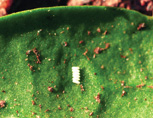
Figure 1: Spinach leafminer egg mass. |
Leafminers are insects that have a habit of feeding within leaves or needles, producing tunneling injuries. Several kinds of insects have developed this habit, including larvae of moths (Lepidoptera), beetles (Coleoptera), sawflies (Hymenoptera) and flies (Diptera). Most of these insects feed for their entire larval period within the leaf. Some will also pupate within the leaf mine, while others have larvae that cut their way out when full-grown to pupate in the soil.
Leafminers are sometimes classified by the pattern of the mine which they create. Serpentine leaf mines wind snake-like across the leaf gradually widening as the insect grows. More common are various blotch leaf mines which are generally irregularly rounded. One subgroup of these are the tentiform leafminers, which produce bulging blotch-type mines that curve upwards somewhat like a tent as the damaged leaf tissue dry. Mining patterns often are combinations of the above, such as species that initially produce serpentine mines but terminate by making the enlarged leaf cavity of a blotch mine.
Areas mined by insects die and dry out. Although injuries produced by leafmining insects can be unattractive, it is rare for them to significantly affect plant health. Also, most leafminers have important natural controls which normally check populations before too much injury is done to plants.
Injuries caused by leaf and needle mining insects can superficially resemble symptoms produced by leaf spotting fungi or other abiotic problems. They can be differentiated by pulling apart the blotchy area. If damaged by insects the leaf or needle will have a hollow area and may expose either
the insect and/or its droppings (frass). Leaf spotting fungi cause these areas to collapse, without
any tunneling.
.
Figure 2: Elm leafminer injury. |
.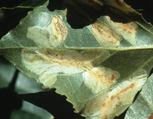
Figure 3: Tentiform leafminer injuries to cottonwood. |
.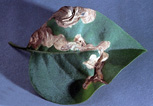
Figure 4: Lilac leafminer injury. Photo courtesy of Ken Gray collection. |
Common Leafminers of Trees and Shrubs
Sawfly Leafminers. Most sawflies chew on the surface of leaves, but four species found in Colorado develop as leafminers of woody plants. Adults are small, dark-colored, non-stinging wasps that insert eggs into the newly formed leaves. The developing larvae produce large blotch mines in leaves during late spring. The sawfly leafminers produced a single generation each year.
Elm leafminer (Kaliofenusa ulmi) is the most important species, being locally common in several Front Range cities where it develops on American, English and Siberian elms. Other species include: hawthorn leafminer (Profenusa canadensis) associated with Crateagus crus-galli, C. persimilis, and C. erectus; birch leafminer (Fenusa pusilla) present in some plantings of white or gray birches; and alder leafminer (Fenusa dohrnii), a native species that develops in alder leaves.
Tentiform Leafminers. Larvae of several tiny moths (Phyllonorycter species) produce blotch mines in leaves that pucker when they dry out, somewhat resembling a pup tent. These tentiform leafminers occur on willows, poplars, and cottonwoods, hackberry and apple and leaf mines tend to be concentrated on the lower, shaded leaves. Probably two generations are normally produced. Outbreaks are rare because these insects are normally heavily attacked by parasites and other natural enemies.
Lilac leafminer. Another small moth, the lilac leafminer (Caloptilia syringella) produces a blotch mine and then folds edge of lilac and privet leaves. A related species, the boxelder leafminer, Caloptilia negundella, produces similar leaf injuries to boxelder leaves. There are two generations per year and the life cycle is likely similar to that of the lilac leafminer.
Needleminers. Several minute moths of the genus Coleotechnites have larvae that develop in the needles of conifers. Affected needles appear brown beyond the tunnels of the larvae. Most important is the ponderosa pine needleminer (Coleotechnites ponderosae) that has periodically produced outbreaks in forested areas of ponderosa pine. Related species occur in lodgepole pine, pinyon, and spruce.
Aspen leafminer. Delicate, winding mines through the upper leaf surface of aspen leaves are characteristic of another small moth, Phyllocnistis populiella. The feeding by the caterpillars that produce the mines produces insignificant damage and is notably mostly because they may attract attention.
Poplar blackmine beetle. Large black blotches in poplar leaves are produced by larvae of a leaf beetle (Zeugophora scutellaris). Adults chew small pits in the leaf. Outbreaks are extremely rare and the insect causes only minor leaf damage.
European elm flea weevil. Probably the newest leafmining insect to establish in Colorado is the European elm flea weevil (Orchestes alni). The larvae make a leaf mine in elm that superficially resembles that of the elm leafminer sawfly. The mine of the European elm flea weevil originates from a leaf vein, meanders in a serpentine form, and ultimately terminates in a leaf blotch along the edge of the leaf. Adults are tiny beetles that jump which makes pits in leaves, producing a lacy appearance of foliage when they are abundant.
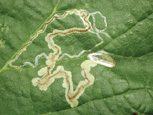
Figure 5: Serpentine leafminer on grape produced by small moth. |
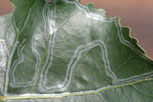
Figure 6: Serpentine mines produced in cottonwood leaf. |
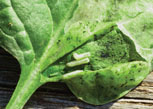
Figure 7: Spinach leafminer mine exposed from leaf mine. |
Management of Leafminers of Trees and Shrubs
Few, if any, leafminers pose any significant threat to the health of trees or shrubs. Injuries are cosmetic and treatment decisions are based on plant appearance.
Furthermore most leafminers have numerous natural enemies that normally well regulate their populations. Outbreaks, if they occur, are usually very short-lived. However, exceptions to this can occur among the non-native species that are not as well regulated by natural enemies in areas such as Colorado where they have been recently introduced. Examples of non-native leafminers are those found on elm (elm leafminer, European elm flea weevil), birch (birch leafminer), and the tentiform leafminers of apple.
If controls are attempted with insecticides there are two approaches to consider. The first involves sprays applied to leaves that are timed to coincide with periods when egg laying occurs – usually shortly after leaves have expanded in spring. Persisting contact insecticides can be used for this purpose, such as the various pyrethroids that currently predominate for control of insects that chew on leaves (permethrin, bifenthrin, lambda-cyhalothrin, cyfluthrin, deltamethrin), None of these will move systemically in plants so active larvae within mines will not be affected. Sprays of systemic neonicotinoid insecticides (imidacloprid, dinotefuran) can provide some control of these stages among leafminers that are beetles (Coleoptera) or sawflies (Hymenoptera). Neonicotinoids tend to be poor in control of caterpillars, the larval stage of moths (Lepidoptera).
Alternately, neonicotinoid insecticides can be applied to the soil for root uptake. Imidacloprid (Merit, various generics) is widely available for this application both through most nursery outlets and by commercial applicators. Dinotefuran (Safari) is presently only available through commercial applicators.
Leafminers of Vegetables and Flowers
Columbine Leafminers. At least two species of leafmining flies in the genus Phytomyza produce leaf mines in columbine. One produces blotch mines while serpentine mines are characteristic of the second species. Adults are tiny dark flies and females make leaf punctures with their ovipositor so that they can drink plant fluids. The presence of small puncture marks is a indication of activity of these insects and can be useful for timing insecticides applied for control.
Vegetable Leafminers. Several Liriomyza species of leafmining flies make long serpentine mines through leaves of flower and vegetable garden plants. Normally these insects are very well controlled by natural enemies and outbreaks are almost always associated with use of insecticides.
Spinach leafminers. The only insect that regularly mines edible parts of plants is the spinach leafminer (Pegomya hyoscyami), which produces large, dark blotchmines in leaves of spinach, beets, and related weeds. Adults are small gray flies, about half the size of a house fly and they emerge in spring to lay eggs on the underside of leaves. The eggs of this insect are quite distinctive, being white and laid in small masses. Problems are most common in gardens where spinach and beets are overwintered and continuously grown, providing host plants for the insects. Injuries most commonly occur in spring but there are two or more generations produced during the growing season.
Controls of Leafminers of Trees and Shrubs
Controls have not been evaluated for the columbine leafminers but they are likely able to be managed in the manner of leafminers on trees and shrubs. Furthermore, the feeding puncture wounds that the flies make can provide an early means of detecting their activity, thus allowing proper timing of treatments applied against the egg laying adults.
No controls for the vegetable leafminers are recommended. Many insecticides have poor activity against these insects and often insecticide applications will make problems worse, by differentially destroying natural enemies.
Spinach leafminers pose different problems as they appear on edible crops. In gardens the most simplest and most effective means of controlling this insect is to regularly check the plants for the presence of eggs, which can be hand crushed. Leaves with actively growing larvae should be picked and destroyed; leaving picked leaves on the ground will allow the larvae to finish development.
*W.S. Cranshaw, Colorado State University Extension entomologist and professor, bioagricultural sciences and pest management; D.A. Leatherman, entomologist, Colorado State Forest Service; and J.R. Feucht, former Extension landscape plants specialist and professor, horticulture. 3/96. Revised 7/14.
Go to top of this page.





